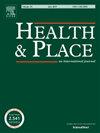加拿大多伦多大麻合法化和大流行病限制后过量使用的邻里风险因素和时空趋势。
IF 4.1
2区 医学
Q1 PUBLIC, ENVIRONMENTAL & OCCUPATIONAL HEALTH
引用次数: 0
摘要
近年来,加拿大多伦多的药物和阿片类药物过量现象大幅上升。为了探索可能的原因,我们从空间上分析了2019-2022年过量用药发生率数据之间的关联,并选择了多伦多社区的社会经济和建筑环境变量。通过时空分析,我们还评估了加拿大2018年大麻合法化(2017-2020年)和COVID-19大流行封锁(2019-2022年)前后的平均面积趋势和当地热点。以前的讨论将大麻视为更危险药物的可能替代品,而大流行封锁可能会减少精神健康和获得护理的机会。我们发现1)过量吸毒发生率与家庭/社区不稳定性和建筑覆盖率呈正相关,2)多伦多郊区的过量吸毒显著增加,3)尽管大麻合法化,平均区域过量吸毒率仍在上升。强效非法阿片类药物的潜在巨大影响和流行病封锁可能会影响这些结果。政策制定者应监测封锁后的吸毒过量趋势,探索减少危害的方法和改善住房选择,作为减少多伦多持续毒品危机影响的政策对策,特别是在市中心以外吸毒过量率上升的地区。本文章由计算机程序翻译,如有差异,请以英文原文为准。
Neighbourhood risk factors and spatiotemporal trends for overdoses following cannabis legalization and pandemic restrictions in Toronto, Canada
Drug & opioid overdoses in Toronto, Canada, have risen substantially in recent years. To explore possible causes, we spatially analyze associations between overdose incidence data over 2019–2022 and select socioeconomic & built-environment variables among Toronto neighbourhoods. Using spatiotemporal analysis, we also assess average area trends and local hotspots before/after two major events: Canada's 2018 legalization of cannabis (2017–2020) and COVID-19 pandemic lockdowns (2019–2022). Previous discussions frame cannabis as a possible alternative to more dangerous drugs, while pandemic lockdowns were likely to reduce mental health and access to care. We find 1) overdose incidence shows positive association with household/neighbourhood instability and percent building coverage, 2) notable overdose increases in Toronto's suburban neighbourhoods, and 3) rising mean-area overdose rates, despite cannabis legalization. Potentially outsized effects of high-potency illicit opioids and pandemic lockdowns may influence these results. Policymakers should monitor post-lockdown overdose trends and explore harm reduction approaches and improved housing options as policy responses to reduce impacts from Toronto's ongoing drug crisis, especially in areas outside the downtown that have rising overdose rates.
求助全文
通过发布文献求助,成功后即可免费获取论文全文。
去求助
来源期刊

Health & Place
PUBLIC, ENVIRONMENTAL & OCCUPATIONAL HEALTH-
CiteScore
7.70
自引率
6.20%
发文量
176
审稿时长
29 days
期刊介绍:
he journal is an interdisciplinary journal dedicated to the study of all aspects of health and health care in which place or location matters.
 求助内容:
求助内容: 应助结果提醒方式:
应助结果提醒方式:


